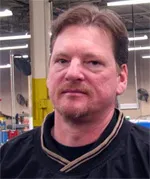This all started with me looking at multiple converter failures. They were due to the converter bolts damaging the backs on Toyota A245E/A246E transmissions that attach to the 1.8L engine. Oddly, we also see this in other Toyota applications, maybe more so than other vehicle manufactures.
My intentions were to order some factory bolts to get the proper dimensions and possibly send these reman units out with new bolts, be they either O.E. or an economical replacement. I was hoping this would eliminate any confusion for the R & R tech on which bolts to use, therefore eliminating unwanted warranties. What I found was very humbling. I have worked on my share of Toyotas over the years and consider myself a well-rounded transmission technician; that's why I was pretty shocked to find out that this transmission/engine combination has two unique torque converter bolts. Five of the six are part #90119-08498 and one is part #90109-08113.
At this point, I ordered some bolts to see what the difference is between the two. I also asked my local dealer to give me a list of vehicle applications that these bolts went in. No surprise, but these bolts fit a wide range of vehicles going back to 1985. Now I am really curious and racking my brain for any memory of the bolts being different.
When the bolts arrived, I could see bolt #90109-08113 had a shoulder; not a very noticeable one, but enough to ensure that if you install this bolt first, it will center the flywheel to the converter. This allows the other 5 bolts (#90119-08498) to be installed without misalignment.
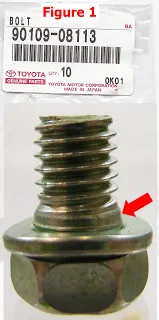
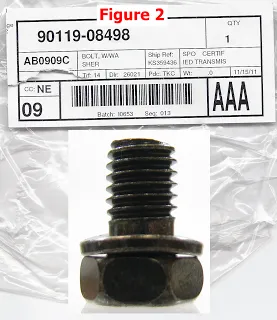
They are also different colors. As I was waiting for them to arrive, I had our purchasing manager and the dealer look at other Toyota transmissions. We discovered that they also had one bolt that was different. I had other bolts ordered for other applications and the one unique bolt was shouldered also and a different color.
You can see how this explains all kinds of scenarios where an R & R technician may resort to searching though his box (or five gallon bolt bucket!) for a bolt to screw into the converter.
When you take all six bolts out and throw them in with the rest of the R & R bolts, you don't really pay that much attention to what color they all are; on top of that, they're probably covered with oil, dirt and dust. So now you are reassembling the unit and you only have five converter bolts of the same color... or do you have all six the same color? Maybe one just came from somewhere else... dust cover, heat shield, five gallon bucket? You follow where I'm going with this?
While talking with my one of my co-workers about these bolts and my thoughts of writing an article about them, it must have triggered the Rolodex in his head. He looked at me and said, "I think there's a bulletin about that somewhere!" Sure enough, after digging though his old Toyota folder, he pulls out Toyota tech bulletin #016 dating back to September of 1989.
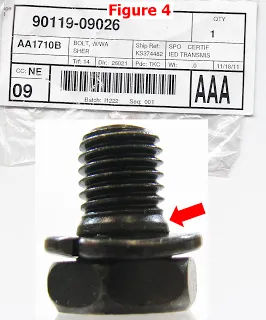
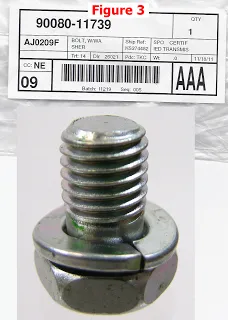
These larger bolts were ordered for a vehicle equipped with A750 in 2003 & up 4runner and are also used in a wide variety of vehicles.
Note the shouldered bolt & non shouldered bolts are different colors but opposite of the other set of bolts in figures 1 & 2.
Moving to a different subject all together, I was thinking of other topics to write about when this thought popped into my head: What transmission failures or broken parts have I seen in my career that I have only seen once? Surely if I have seen it once that is not the only time it has ever happened. So here are some parts failures on 4R100s & E4ODs that I have only seen once.
It is part of a normal overhaul on these transmissions to address the wear at the case and center support by machining down the support & installing a snap ring inside the case. This not only reclaims the parts (case & support), but it makes for a better transmission by helping to distribute the load over the whole outside diameter of the support.
Here is a picture of an overdrive intermediate piston housing that has a hairline crack in it due to a much worn case & support. The housing got to rocking up & down so much that it cracked at the bottom of the overdrive feed bolt hole.
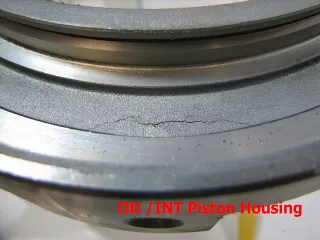
This other picture is not of an actual broken case but where I have seen them crack due to the same wear issue of the case and support or over-torquing the feed bolts during previous rebuilds. In both the forward & overdrive feed bolt whole pockets on separate occasions I have seen small crack. These cracks were almost impossible to see when inspecting the case empty. It was only after you torque the bolts & sucked the case down to the supports that the cracks were noticeable... yep, after you are almost completely done building the transmission & you will not catch this on a routine air test though the bolts.
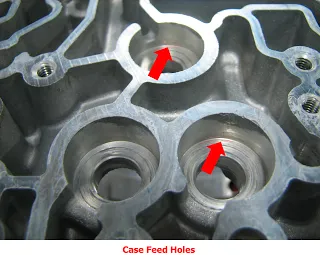
I have also seen Loctite build up give a false torque reading on the feed bolts and the shoulder of the bolt never seals against the case. The problem is a combination of old Loctite in the hole & the new Loctite on the new bolts creating too much resistance. A build tip that can catch this is before you install the separator plate with transmission V.B. mating surface facing up, squirt some oil in the feed bolt hole cavities around the head of the bolt & see if it drains though to the inside of the case.
 Certified Transmission
Certified Transmission
